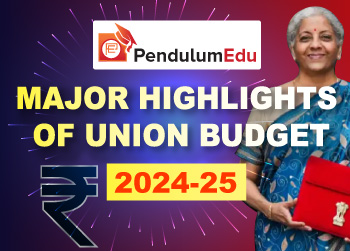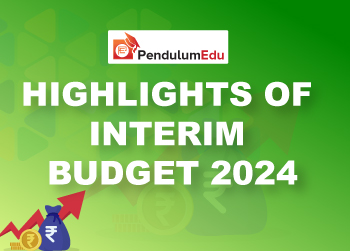Topic: Indian Economy/Financial Market
1. India imported 58 million tonnes (mt) of coking coal in FY24, the highest amount in ten years.
- Steel mills' increasing demand was the driving force behind this.
- Over a ten-year period, imports increased by more than 20% and by 7% year over year (from 54.3 million tonnes in FY23).
- Russia's supply is at multi-year highs, with 6.4 million tonnes in FY24.
- This was an increase of 200% year over year (from 2.3 mt in FY23) and 300% over a six-year period (from 1.6 mt in FY19).
- India is still one of the world's top importers of coking coal.
- During the past ten years, imports of coking coal have ranged from 47 to 54 million tonnes.
- Australia remained the leading supplier of coking coal for FY24. It represented 34.2 mt, or 59%, of all shipments.
- Australia lost market share to the USA, with 14% of the market at 8.4 million metric tonnes of supplies, and Russia, which currently holds a 12 percent market share.
- Eighteen percent of coal exports six years ago came from Australia, three percent came from Russia, and eight percent came from the United States.
- Russia surpassed nations like Canada and Mozambique to become the third-largest supplier of coking coal.
- India produced 52 mt of sponge iron in FY24, growing 20 percent year over year from 43 mt in FY23.
- India produced 143 mt of crude steel in the previous fiscal year, a rise of almost 14%. A year earlier, 127 million tonnes of steel were produced.
Topic: RBI
2. Two draft guidelines for the regulation of payment aggregators (PA) have been released by RBI.
- The guidelines deal with the net worth, licencing regulations, and physical Point-of-Sale (PoS) actions of PA participants.
- The second circular addresses upgrades and changes to escrow account operations, merchant due diligence, and KYC.
- The two draft directives aim to strengthen the payment ecosystem even more.
- The RBI declared in September 2022 that offline PAs handling proximity/face-to-face payments would be regulated.
- Online PAs (PA-O) and those that enable in-person or proximity payment transactions (PA-P) are part of India's payments ecosystem.
- PA-P banks are required by the draft guidelines to adhere to the final standards within three months of their release.
- The RBI must be notified of the intention of non-bank firms offering PA-P services to seek authorization within sixty days of the circular's release.
- By May 2025, they will have to file an application.
- If non-bank PA-Os want to keep doing PA-P operations, they will also need to apply for RBI approval within 60 days.
- When applying, non-banks offering PA-P services must have a minimum net value of ₹15 crore, and by March 31, 2028, they must have a minimum net worth of ₹25 crore.
- At the time of application, new non-bank PA-P applicants must have a minimum net worth of ₹15 crore.
- It is necessary that they increase it to ₹25 crore by the conclusion of the third fiscal year after the authorization was granted.
- According to the RBI, non-bank PA-P that are currently in operation and are unable to meet the net worth criterion or who do not apply for authorization within the allotted time frame will cease their operations by July 31, 2025.
- The RBI further stated that, starting on August 1, 2025, no party involved in the card transaction or payment chain shall retain card-on-file data for face-to-face or proximity payment transactions made with cards.
- Only the card issuers or card networks shall retain such data.
Topic: Miscellaneous
3. Former RBI governor D Subbarao’s memoir has been released.
- The book is titled 'Just A Mercenary?: Notes from My Life and Career'.
- It is authored by D Subbarao himself. Subbarao was finance secretary (2007-08).
- He took over as the governor of the RBI on September 5, 2008 for five years.
- He took over as RBI governor a few days before the breakout of the Lehman Brothers crisis.
- On September 16, Lehman Brothers crashed into bankruptcy. It became the biggest corporate failure in history.
- In a chapter titled 'Reserve Bank as the Government’s Cheerleader?', Subbarao recalled about the pressure from the government.
- Duvvuri Subbarao was the 22nd Governor of Reserve Bank of India. He served under Prime Minister Dr. Manmohan Singh.


Topic: RBI
4. Lenders have been asked by RBI to provide Key Fact Statements (KFS) to the borrowers.
- As per RBI, they shall provide KFS to the borrowers of all new retail and MSME term loans, which will be sanctioned on or after 1 October, 2024.
- This direction also applies to fresh loans to existing customers.
- KFS includes key information about a loan agreement, which include an all-in cost of the loan, in an easy to understand and simple format.
- RBI has issued a circular about KFS to regulated entities like all commercial banks, co-operative banks, and non-banking financial companies (including housing finance companies).
- RBI said they shall provide KFS to help borrowers make an informed decision before executing the loan contract.
- RBI has exempted credit card receivables from the provisions contained under the circular.
- As per the circular, the KFS shall have a unique proposal number. It will have a validity period of at least three working days for loans having tenor of seven days or more.
- The KFS will have a validity period of one working day for loans having tenor of minimum seven days.
- The validity period is the amount of time during which the borrower has to accept the terms of the loan after receiving the KFS from the Regulated Entity.
- A computation sheet for the annual percentage rate (APR) and a schedule of loan amortization over the loan duration will be included in the KFS.
- The APR will also include any costs that are actually recovered from the borrowers by the Regulated Entities on behalf of outside service providers, such as insurance and legal fees.
- These fees must be revealed individually.
- At no point throughout the loan term may the Regulated Entities charge the borrower any fees or charges not specified in the KFS without the borrower's express approval.
Topic: Indian Economy/Financial Market
5. BDO India is establishing a Global Capability Centre (GCC) at Noida in Uttar Pradesh.
- This is being established under a newly formed entity by the name of BDO EDGE (Exceptional Delivery for Global Enterprises).
- GCC will aim to hire 5,000 professionals in next 3-4 years.
- BDO India is a part of BDO global network of accounting and advisory firms.
- BDO EDGE is an India-based Global Capability Centre.
- It has been set up as a joint venture of BDO member firms in India, the United States, the United Kingdom and Germany.
- BDO EDGE is an independent member of the BDO network.
- It is set up to improve the capabilities and resources of member firms.

Topic: Indian Economy/Financial Market
6. According to a UNCTAD report, India’s economy will grow at 6.5% in 2024.
- This projection comes after India’s growth of 6.7% in 2023.
- United Nations Conference on Trade and Development (UNCTAD) report highlights India as the fastest-growing major economy globally.
- Multinational corporations are growing their manufacturing operations in India in order to improve the diversification of their supply chains, as per the UNCTAD report.
- RBI has projected 7% growth rate for the current financial year 2024-25.
- ‘2024 Financing for Sustainable Development Report: Financing for Development at a Crossroads’ was launched last week.
- Global growth is projected to be 2.6% in 2024. This is projected to be slightly slower than the 2.7% in 2023.
- India's growth forecast for 2024 was increased by the International Monetary Fund (IMF) from 6.5% to 6.8%.
- India continued to be the emerging market and developing economy with the fastest rate of growth.
- The IMF projected India's growth rate to be 6.5% for 2025.
- Its growth expectations were supported by strong and stable domestic demand as well as an increasing number of people in working age.
- According to the IMF's most recent World Economic Outlook report, during the medium term, approximately two out of every three new workers worldwide would come from sub-Saharan Africa and India.
- Over the previous 20 years, the Group of Twenty (G20)'s 10 emerging countries have continuously outperformed advanced economies in terms of economic growth.
- Since 2000, the G20 emerging markets' percentage of the global GDP has more than doubled.
- India's official statistics show that during the October–December quarter of the fiscal year 2023–2024, the India grew by an 8.4%.
- India's GDP expanded by 7.8% and 7.6% in April-June and July-September in 2023–2024, respectively.
- India's GDP expanded by 7.2% in 2022–2023 and 8.7% in 2021–2022, respectively.
- In general, the IMF projected 3.2% global growth in 2024 and 2025, respectively.
Topic: Indian Economy/Financial Market
7. In March, India's goods trade deficit narrowed to an 11-month low of $15.6 billion.
- An official data on April 15 showed that India's goods trade deficit in March narrowed by nearly 17% from the previous month as imports fell sharply while exports rose marginally.
- According to Commerce Ministry data, the deficit declined to $15.6 billion in March, from $18.71 billion in February and $16.02 billion in January.
- This is the lowest in the last 11 months, with the last time the deficit was this low in April 2023 when it came in at $14.44 billion.
- The March figure was much higher than economists' estimate of a deficit of $18.55 billion.
- In March, Goods exports rose marginally to $41.68 billion from $41.40 billion in February amid a slowing pace of global trade growth during 2024.
- In March, the total value of merchandise imports fell to $57.28 billion from $60.11 billion in the previous month.
- In March, services exports stood at $28.54 billion, down from $32.15 billion in the previous month.
- In March, services imports rose marginally to $15.84 billion from $15.39 billion in February.
Topic: Indian Economy/Financial Market
8. India's overall export (Merchandise and Services combined) in March 2024 is estimated to be USD 70.21 Billion.
- In March 2024, India's overall export (Merchandise and Services combined) showed a negative growth of (-) 3.01 per cent over March 2023.
- Overall import in March 2024 is estimated to be USD 73.12 Billion. It shows a negative growth of (-) 6.11 per cent over March 2023.
- India's overall exports (Merchandise and Services combined) in FY 2023-24 (April-March) are estimated to be USD 776.68 Billion. It exhibits a positive growth of 0.04 per cent over FY 2022-23 (April-March).
- Overall imports in FY 2023-24 (April-March) are estimated to be USD 854.80 Billion. It shows a negative growth of (-) 4.81 per cent over FY 2022-23 (April-March).
- Merchandise exports in March 2024 were USD 41.68 Billion, as compared to USD 41.96 Billion in March 2023.
- As compared to USD 60.92 Billion in March 2023, Merchandise imports in March 2024 were USD 57.28 Billion.
Topic: Indian Economy/Financial Market
9. India’s wholesale price inflation increased from 0.2% in February to 0.53% in March.
- In March, wholesale price inflation has increased to the three-month high level.
- Food index increased 4.65%. The increase in cereals prices mainly contributed to rise in food index.
- Cereals prices increased at 12-month high pace with the rise in inflation in paddy (11.7%), potato (53%) and onions (57%).
- Inflation in pulses and vegetables stood at 17.2% and 19.5%, respectively.
- Fuel, power and manufactured products have continued to show deflation.
- However, the level of their price decline from a year ago moderated to nearly 0.8% in March.
- On a month-on-month basis, the WPI increase 0.4%. The food index increased 1.01% and primary articles increased 0.9%.
- Wholesale Price Index (WPI) for January 2024 has been revised by the Commerce and Industry Ministry and inflation rate for January 2024 has been raised to 0.33% from 0.27% earlier.
- Within food articles, the prices of eggs, meat and fish declined 1.86%.
- Milk inflation declined from 5.5% in February to 4.7% in March. Wheat price rise increased from 2.34% in February to 7.43% in March.
- Increase in prices of food articles, electricity, crude petroleum & natural gas, machinery & equipment and other manufacturing, etc is the primary reason for positive inflation rate in March 2024.
Topic: Indian Economy/Financial Market
10. India now has record-high foreign exchange reserves of USD 648.562 billion.
- Based on the most recent data released by the Reserve Bank of India (RBI), this is the eighth week in a row that there has been an increase in foreign exchange reserve.
- Foreign Currency Assets (FCA) increased by USD 549 million to USD 571.166 billion, causing the growth in foreign exchange reserves.
- Moreover, reserves of gold increased by USD 2.398 billion to USD 54.558 billion.
- Following a cumulative fall of USD 71 billion in 2022, the RBI increased the foreign exchange reserves by roughly USD 58 billion in 2023.
- The reserves have increased by almost USD 28 billion so far in 2024.
- Foreign exchange reserves reached last time a peak in October 2021.
- The majority of foreign exchange reserves are kept in reserve currencies like the US dollar, Euro, Japanese Yen, and Pound Sterling.



 Previous
Previous 
 Latest
Latest 








Comments